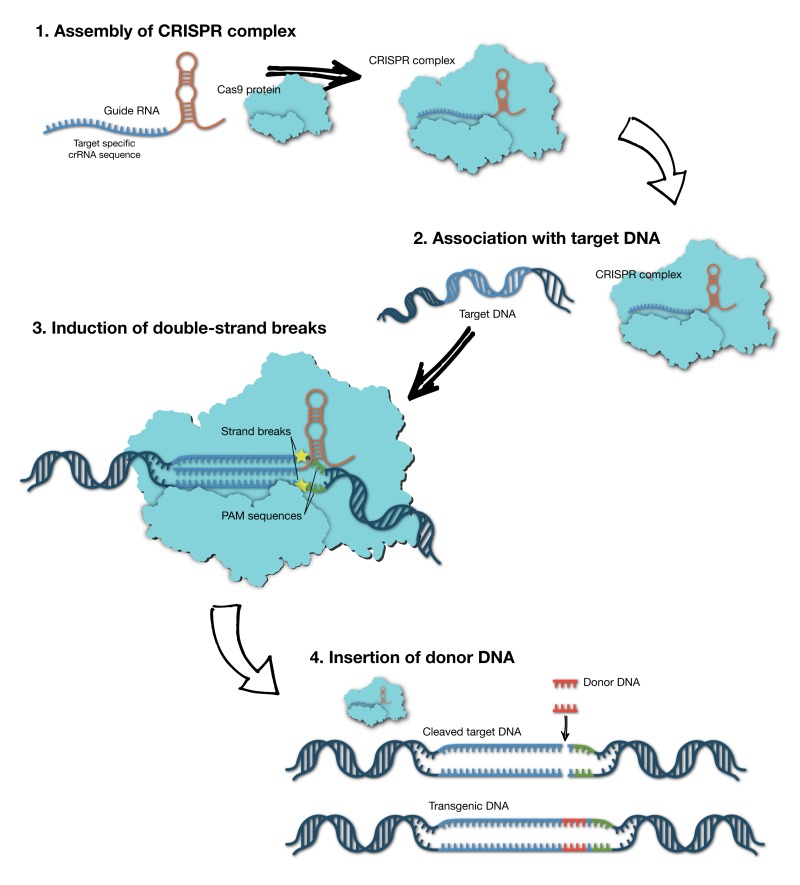Crispr-Cas9 is a genome editing technique which has transformed the genetic editing making it simpler, faster and accessible by most laboratories. This technique has grown as sharp genetic scissor with biological applications like editing genes for a future possibility of curing inherited diseases. Crispr stands for clustered regularly interspaced short palindromic repeats which is a family of prokaryotic genomes from the organisms of family of archaea and bacteria. Crispr-Cas is a prokaryotic immune system which provides resistance towards foreign genetic elements like phages and plasmids. This helps in setting up of an acquired kind of immunity in the prokaryotic system. Cas proteins generally show nuclease and helicase motifs. An identifying region in the transcripted RNA coming out of the CRISPR gene are the spacer-sequences (non-coding) which helps the Cas protein to identify foreign DNA. Some of the Cas proteins under the intracellular molecular guidance of RNAs cut foreign RNA.
The relevance of memory cells has been highlighted by various researches triggered due to the currently ongoing Covid19 pandemic across the world. These cells help in the production of specific antibodies in order to counter the virus infection. Importance of the CRISPR lies in the fact that it helps in identifying external threats like viruses. The CRISPR-associated genes code for the Cas proteins like Cas-9 which chops and destroys the DNA of the infecting cells. Crispr-Cas system has been known to activate the P53 protein which acts as a cellular gatekeeper and prevents the cells from turning cancerous. The activated P53 acts to take away the chance of the cells to turn cancerous if the DNA repair fails after the cuts by the CRISPR system are detected. Thus the presence of a functional P53 makes the Cas mediated changes less probable as a measure against cancerous growth.
The Nobel Prize for Chemistry for the year 2020, was announced to be given to Jennifer Doudna and Emmanuelle Charpentier for the development of this CRISPR-Cas 9 system which helps in editing of genes.
Emmanuelle Charpentier studied the Streptococcus pyogenes, a species of facultative gram-positive bacteria which is generally associated with diseases like tonsillitis, Pharyngitis, Rheumatic fever, Necrotizing Fasciitis and Scarlet fever. During her studies, she discovered a hitherto unknown bio-molecule, tracrRNA in the species. She deduced that the tracrRNA is part of an ancient prokaryotic defense (immune) mechanism, CRISPR-Cas which cleaves and destroys the genomic materials of the virus which invades the bacteria. This discovery of the CRISPR-Cas system was published by Emmanuelle in the year 2011, the same year, when she began a collaboration with Jennifer Doudna. This collaboration was crucial as this led them to recreate the library of the bacteria’s molecular genetic scissors. It further led them to control the scissors so that the CRISPR-Cas library molecules can cut the DNA at a predetermined site.
There have been other gene-editing techniques like Zinc-finger Nucleases and TALENs, but the CRISPR-Cas system is easier to use and more adaptable. The game-changing potential of this genetic scissor is highlighted by the fact that the discovery is awarded the Nobel Prize within a decade of its main seminal findings.
In June, this year, as announced by the Gene editing company- CRISPR Therapeutics, two patients with β-thalassemia and one with sickle-cell anemia, were found to no longer need any blood transfusion as the stem cells in their bone-marrow were edited using CRISPR method. This method of editing out the genes responsible for diseases is currently propagated and identified as bio-hacking.
Jennifer Doudna has recently started a company, Scribe Therapeutics, which would start working on amyotrophic lateral sclerosis using the CRISPR-Cas technique. In India, a Covid19 testing kit named Feluda (named after the iconic fictional Bengali detective created by Oscar-winning Film-Maker Satyajit Ray) has been developed by the CSIR- Institute of Genomics and Integrative Biology based on the CRISPR-Cas system.
On the other side of the CRISPR story, a Chinese researcher He Jiankui had used it to create a pair of twins (Lula and Nana) with edited genes. The gene CCR5 was edited out to offer protection against HIV infection. The editing did not protect against HIV infection, but it had caused other unintended mutations. For this He Jiankui was condemned, was removed from his position at Shenzhen University, and sentenced to three years in jail.
The Nobel Prize-winning discovery of the CRISPR-Cas system is hence an important step in molecular biology and biochemistry with medical applications. It lies within the intent of humans as to how they use this discovery.





